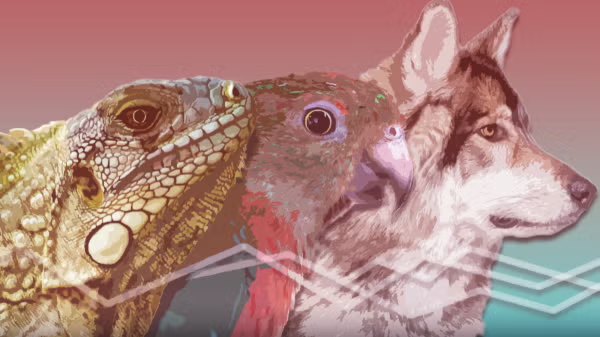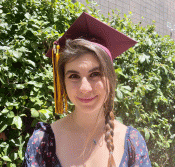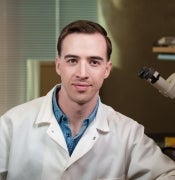Barrett alum's publication of undergraduate research as first author a rare feat

Tagged honeybees from the ASU hive. Photo by Sebastian Scofield
Two years ago, when Angela Oreshkova was still a biology student in Barrett, The Honors College at Arizona State University, she spent many of her days in a lab, leaning over a plexiglass dish with a syringe full of sugar water, meticulously feeding honeybees. Now, all of that patient, careful work has paid off: Oreshkova recently published the results of her research in PLOS One as a first author, a rare accomplishment for undergraduate researchers.
“I still can’t believe it myself,” Oreshkova said with a smile.
She is now in her first year of medical school at Midwestern University, where she’s considering a variety of paths within the medical field, from anesthesiology to emergency medicine.
As an undergraduate researcher in the Amdam Lab at ASU, Oreshkova investigated the effects of queen mandibular pheromone (QMP), a chemical that the queen bee releases to regulate certain traits in her worker bees. For their first few weeks of life, workers stay inside the hive, caring for other bees in the colony. As they age, they transition into foragers, venturing out to collect pollen and nectar. Many animals get fatter as they age, but not honeybees. Sebastian Scofield, a PhD candidate and Oreshkova’s research mentor, explained that “that’s a really odd result, because the foragers are basically drinking high-fructose corn syrup 24/7.”
“People have been looking at why that is for a long time,” Scofield said, “and so we were exploring one possible mechanism, which was that there was this pheromonal exposure and this loss of pheromonal exposure as these bees transition from inside of the nest to outside of the nest.”
Other researchers had found that QMP increases worker bees’ capacity to store lipids in the form of fatty acids. Oreshkova and Scofield were looking into why that might be. They found that QMP didn’t directly affect the worker bees’ capacity to store lipids, ruling it out as the reason for why honeybees lose body fat as they age. Scofield’s PhD research continues to look into that question, for which he recently also just published a first-authored paper of his own.
Though Oreshkova’s project didn’t answer that long-standing question, she did learn about the mechanisms behind some of QMP’s other effects, like increasing the size of a gland in the worker bee’s brain that makes protein-rich food for other bees to eat; she suspects QMP increases the gland size by suppressing some other juvenile hormones. Plenty of researchers have studied the effects of these chemicals before, but not the mechanism, which Oreshkova insists is “just as important.”
When PLOS One first accepted Oreshkova’s manuscript to be reviewed, she was overjoyed. But months later, the paper got sent back –– not because of the quality of the research, but because the journal couldn’t find enough peer reviewers. Rather than giving up, Gro Amdam, a professor in ASU's School of Life Sciences and director of the Amdam Lab, encouraged Oreshkova to submit a letter of appeal to the journal, arguing that it was the journal’s responsibility to find reviewers and that the critiques given were not enough to have the paper rejected. Submitting a paper as an undergraduate researcher can be intimidating enough, but Oreshkova went even further by taking her mentor’s advice and arguing with a high-impact journal. Thankfully, her argument worked.
Oreshkova describes that experience as “empowering.”
“It felt good to stand up for my paper and what we did, because we put so much time into it,” she said.
“It was just so awesome to see how she sort of took on the challenge of the rebuttal to the journal and how it paid off,“ Amdam said. “What an experience!”
Amdam invites many undergraduate researchers into her lab, pairing them with graduate student mentors. But Oreshkova is one of the only ones to have a first-authored paper, which her mentors see as a reflection of her work ethic.
“Angela was really a model undergrad in terms of how hard she worked," Scofield said. "She came into the lab with absolutely no research experience, and she went from that to a first-authored paper in two years. That was really impressive.”
Amdam agrees. “Angela was such a gift to the lab," she said. "As a person, she is just fantastic.”
More Science and technology

NASA launches space telescope to chart the sky and millions of galaxies
California’s Vandenberg Space Force Base was the site for Tuesday’s 8:10 p.m. launch of the NASA SPHEREx mission aboard a SpaceX Falcon 9 rocket.The SPHEREx (Spectro-Photometer for the History of the…

ASU-led Southwest Sustainability Innovation Engine funds 8 promising tech startups
In the startup world, tech companies often fall victim to what’s known as the “valley of death” — the gap between technological proof of concept and actual viable product.Aiming to bridge this…

New study explores the link between diet, blood sugar and cancer risk across species
Researchers have long known that diet exerts a profound influence on health, including the risk of developing cancer. A new study, led by researchers at Arizona State University, explores the…

